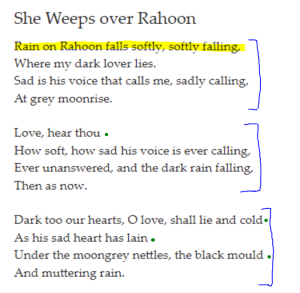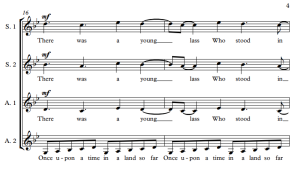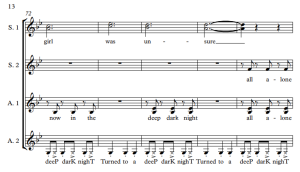Text: Discussion and Examples
Audry Ricks and Grace Weaver
Contextual Background Understanding
Before reading the text, spend some time researching its background. Understanding the background of the text brings powerful insights. We see this in the piece “O Love” composed by Elaine Hagenberg and with text written by the poet and minister George Matheson. Matheson became blind, causing his fiance to leave him. His sister took care of him while he faced the new challenges. As his sister prepared for her own wedding, the pain and heartache of his lost lover came to the forefront of his mind. In these conditions, George Matheson wrote the text to this poem. It’s also important to note his religious background because this could change the interpretation of the text. Consider the first stanza of the poem. How could this be interpreted in multiple ways? Who is Matheson’s audience? Who could he be writing about? Knowing this background and context in which the poem was written increases depth of the message of the piece for the reader.
O Love that will not let me go, I rest my weary soul in thee. I give thee back the life I owe, that in thine ocean depths its flow may richer, fuller be.
Excerpt from “O Love” written by George Matheson
SOURCE: https://hymnary.org/text/o_love_that_wilt_not_let_me_go
Reading the Text
Reading a text out loud can help singers understand its natural flow. Directors can use this to determine how to sing a passage with the corresponding text, using the same emphasis in singing that they would in normal speech. A group that can sing with correct emphasis and musicality relating to text sounds much more advanced, mature, and professional. Looking at the example “O Love,” the pattern is an unstressed syllable followed by a stressed syllable:
O Love | that will | not let | me go
Determining section breaks in a text can assist a director in musical decisions. For example, if a director knows that the text has a stanza break that is sung through in the piece, he or she might choose to have the choir take a lift at the break to make a clear distinction between sections.
Analyzing the Text for Meaning and Structure
After gathering a general idea of the text, it is time to dig deeper. Read the text again a few more times and pay attention to anything notable. Some things to look for include repetition of words, phrases, or ideas, rhyme scheme, mood, and (if it’s a poem) other poetic concepts. There are many ways to approach this, so it is important to find a comfortable approach. Our suggested approach is as follows.
First, looking at the title indicates the tone of the text. In “She Weeps over Rahoon” composed by Eric Whitacre and text by James Joyce, the title suggests a somber emotion. “Rain,” “falling,” “dark,” “sad,” “love,” “falling,” “calling,” “unanswered,” and “cold” are words that stand out in building the overall message.
The structure can also be identified. For reference, the highlighted section is an example of a line, the bracketed areas represent a stanza , and enjambments are indicated with a green dot. Looking at the overall structure of the text, one might predict that the music will likely be broken up into at least three main sections. The middle section seems to contrast the most, indicating that there might be a potential shift in character, harmony, or other elements when set to music.

Analyzing the Music to Text Relationship Through Listening
Once a text analysis is complete, one can advance to analyzing text-to-music relationships. Some examples of the text-to-music relationship are below.
Many of the evocative words in “She Weeps Over Rahoon” are indeed highlighted with text painting. These diagram below links to an interactive page where you can listen to each of these examples of text painting. For example, the beginning of the second stanza does change harmonically and in character, bringing a more tender mood by raising an Eb to E natural, creating a C major chord at the word “love.” As another example, the soprano and alto alternate singing “calling,” musically depicting the act of calling. In that same measure, the word “falling” is depicted by a descending motif.

Identify Trends, Contrasts, and Broken Expectations
Music is about repetition, similarities and differences, and creating and breaking expectations. In “The Music of Stillness” by Elaine Hagenberg, overall trends that match the title include using a lot of I and IV chords, I giving a sense of stability and IV often being associated with a pastoral and calm sound. I and IV chords give a sense of rest because they help the music feel grounded, stable, and consistent by containing the tonic note that is emphasized in the pedal tone in the piano. In fact, almost the entire first section of the piece consists of the three diatonic chords that contain the tonic note: I, IV, and vi, as shown in the annotated diagram of the first section below. Beginning with simple rhythms and the presence of long-held notes on the tonic also add to the tranquil character. Avoiding V chords that bring a sense of movement, and instead using iii to I to cadence, is also a common trend found throughout.

An example of breaking expectations occurs in “The Embers Tell” by Mattea Williams. There is a recurring ostinato using a 3+3+2 rhythmic pattern that is tied to the character of the little girl in the story. The girl is lost and trying to get home, fear continually increasing as the song progresses. The composer demonstrates this by breaking the expectation and changing the rhythm of the girl’s ostinato into elongated patterns. Looking at these two excerpts, what differences do you note in these passages? How can it affect the interpretation?

The Embers Tell mm. 16-17 – Ostinato

The Embers Tell mm. 72-75 – Broken Expectation
Drawing out the ostinato breaks the preestablished expectation of a faster pattern as we see in measures 16 and 17. This change makes the listener feel unsettled and uncertain due to the abrupt change and contrast to what has been heard previously.

